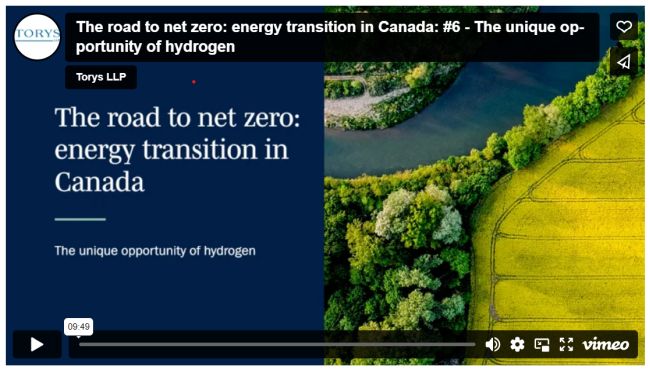With the burning of hydrogen producing no output except for water, it has long been seen as a promising source of fuel. Now it is increasingly attracting interest and investment from across the country, and this fuel of the future may become the fuel of the present.
In this video, Adam Banack, Tim Pavlov and Taylor Campbell explain why hydrogen holds so much potential for Canadian industry and society, and what governments are doing to encourage its rise.
Click here to see other videos and webinars in this series.
Video transcript
Adam Banack (00:06): Hi. I'm Adam Banack, counsel in Torys' Infrastructure and Energy Practice. And I'm joined today with my colleagues Taylor Campbell, from our Calgary office, and Tim Pavlov, with me in Toronto. Both are associates in our energy regulatory group. We're going to talk today about recent developments in hydrogen in Ontario and Alberta and how it fits into Canada's transition to net zero by 2050, and the target milestones that our nation is driving towards along the way.
Adam Banack (00:39): As of now, the world has not found the singular answer to achieve net zero by 2050, and thus we expect that there will be room for a diversified mix of clean and renewable forms of energy. Hydrogen is a particularly interesting piece of this mix because of its flexible application. Some consider it to be the fuel of the future. To level set, there are four main forms of hydrogen power generation. Gray hydrogen, produced through natural gas, absent carbon capture technologies. Blue hydrogen, which is Gray hydrogen with the inclusion of carbon capture. Green hydrogen, produced using renewable energy generation sources such as wind, solar, hydroelectric among others. And pink hydrogen, produced through nuclear power. On earth, pure hydrogen is scarce and mainly exists as part of water. There are several different processes that are currently used to split water into hydrogen. At a later point, the hydrogen can then be mixed with oxygen to produce heat and electricity that is harnessed as fuel. The most interesting part of this process is that the sole output is water. So if we're able to create affordable and abundant hydrogen produced from renewable energy sources, it is truly a green fuel. I view this as a particularly interesting time for the development of the hydrogen industry because we're seeing significant government, financial and political support in collaboration with industry on potential applications for hydrogen. We're seeing Canadian companies participating in the development and scaling of hydrogen technologies, resulting in new jobs for Canadians and new Canadian intellectual property. Canada has entered into supply agreements to export hydrogen to Europe, commencing between 2025 and 2030 and could prove to be another revenue-generating natural resource for our country. And there are vast potential applications for hydrogen, including fuel for long distance transportation, planes, trains, cars, trucks and ships, and using construction and mining applications. Fuel for heavy industry such as steel and concrete manufacturing, which are energy-intensive processes that rely heavily on fossil fuels. As a battery, it can be used to store excess energy generated by the grid during off-peak hours. And finally, it can be blended with natural gas. Despite the enthusiasm and support of government and the private sector, this industry is not without obstacles and we're proud to support our clients who are at the forefront of this revolution navigate and overcome these obstacles. At this point, I'll pause and turn to Taylor to provide an update on recent developments in Alberta.
Taylor Campbell (03:30): Alberta is well-posed to become a leader in the blue hydrogen market. It has abundant natural gas and expertise with carbon capture, utilization and storage. In 2021, the Government of Alberta released its hydrogen roadmap, one of the areas that it highlighted for growth is residential and commercial heating. By blending natural gas with hydrogen that's used to heat and fuel homes and businesses, we have the potential to reduce greenhouse gas emissions associated with those activities. In 2022, the Alberta government asked the Alberta Utilities Commission or “AUC” to conduct an inquiry into the possibility of blending hydrogen with natural gas distribution systems in Alberta. The AUC released its report publicly in September 2022. I'm just going to highlight a couple of the key findings that came out of that report. First is the AUC was generally supportive of the concept of blending hydrogen into natural gas in Alberta. However, in keeping with Alberta's largely deregulated market, the AUC suggested that competitive markets can and should be providing services for many market segments relating to hydrogen, including production, storage and transportation. Regulated utilities should be limited to the blending and distribution functions associated with hydrogen blending. The AUC also highlighted some further policy directions that it's hoping to have from the provincial government in order to approve these projects. Alberta, like many jurisdictions, is facing rising energy costs and the AUC is concerned that hydrogen blending could result in higher costs for consumers, which may not be in the public interest. The AUC highlighted a couple of policy options that would assist it in approving hydrogen blending projects by natural gas distributors. The first is clear policy direction that would allow the AUC to place a greater emphasis on the environmental benefits associated with hydrogen blending. Another option highlighted by the AUC is for some form of government subsidy or relief that could help offset any additional cost to consumers associated with hydrogen blending. The government said that it would be working with stakeholders to build on this report and develop a hydrogen blending framework for Alberta. Of course, with recent changes in cabinet and an upcoming election, we'll have to see whether this remains a priority for government moving forward. This will definitely be an interesting issue to watch though in the coming months and years. Governments and societies are looking for ways to reduce carbon emissions, including with heating systems. Electrification of heating is another option to reduce greenhouse gas emissions, but would require significant upgrades to the electrical infrastructure, which would require both time and money. Hydrogen blending could help reduce the greenhouse gas emissions, largely using the existing gas distribution systems, making it a feasible option in the near term. And now for some updates on the Ontario market. I'll pass it off to Tim.
Tim Pavlov (06:40): Similar to Alberta, Ontario's taking steps to develop the hydrogen economy in the province. Ontario is well-positioned to drive growth in hydrogen economy, particularly green hydrogen with our clean electricity supply supported by an extensive natural gas distribution system. In this regard, the Province of Ontario released a Low-Carbon Hydrogen Strategy last year that identifies, among other things, eight immediate projects aimed at enabling production and expanding hydrogen economy in the province. We are very excited to see such developments and looking forward to seeing more investment in projects supporting these steps. While I'm not going to talk about all eight initiatives set out in the strategy, I'd like to briefly highlight a few. The first one is the Niagara Falls Hydrogen Production Centre, proposed by Atura Power, a subsidiary of Ontario Power Generation, developed its first site for large-scale hydrogen production. If successful, the facility is expected to achieve commercial operations by the end of 2023. The proposed facility would include a 20-megawatt electrolyzer that would use off-peak electricity generated at the Sir Adam Beck Hydroelectric Generating Station to produce green hydrogen to be used primarily for heavy duty trucking, municipal mobility and by heavy industrial customers in Ontario, to be equivalent to taking more than 4000 cars off the road, which will help to reduce greenhouse emissions. The Government is supporting the proposal for a regulatory exemption to the gross revenue charge for electricity used by this project. Another interesting initiative is the development of interruptible electricity rate that would produce reduced electricity rates to support green hydrogen production. In particular, a proposed interruptible rate would offer large electricity consumers reduced electricity rates in exchange for reduced consumption during system or local reliability events. There are various options that are on the table and the Government is currently working with the IESO to develop a high-level design of the program. Following the initial development work, the Ministry of Energy intends to consult with stakeholders and to determine and design details for 2023 rollout as a pilot. For other initiatives the Ontario government is contemplating, and some of them include identifying additional locations across the province, hydrogen hubs, where the demand can be matched by hydrogen production that leverages existing electricity infrastructure, or invisibility of hydrogen opportunities at the Bruce Nuclear Station, developing regulatory framework and supporting hydrogen storage in grid integration pilot projects. So those are the things that are happening in Ontario right now.
Adam Banack (09:37): Thanks for joining us for this video. And for more information on our Hydrogen Practice, please visit us at www.torys.com.
The content of this article is intended to provide a general guide to the subject matter. Specialist advice should be sought about your specific circumstances.




